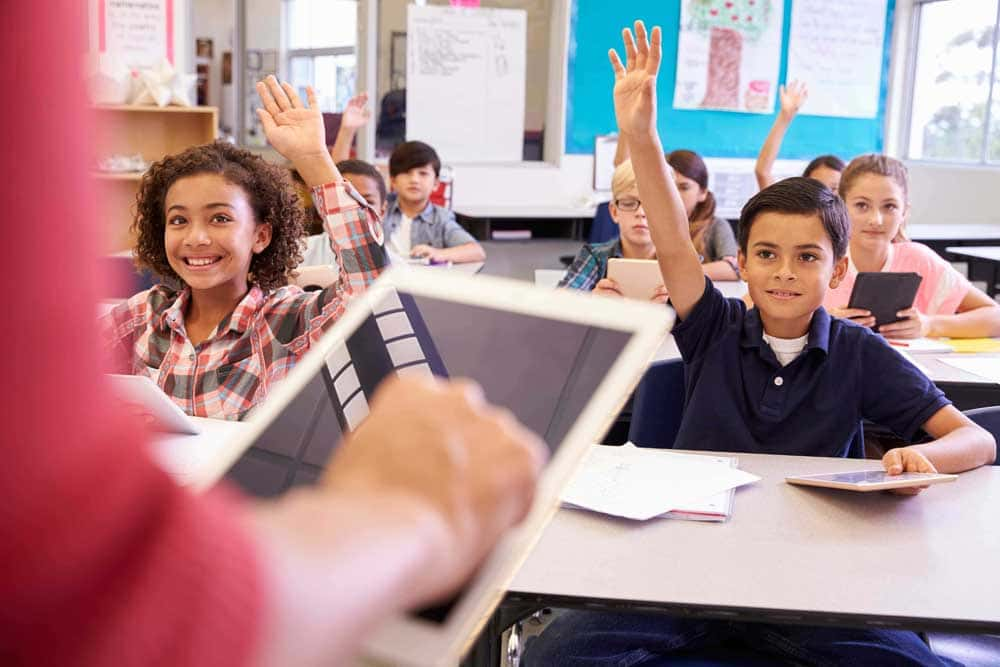The growth of eLearning isn’t just about online courses. Many of the technological advancements in the education industry are about what happens inside the classroom. Technology such as computers, laptops, tablets and smartphones become more and more present in our lives. So, it makes sense for these useful tools to be gaining a much greater presence in the classroom, too. Most schools, colleges, universities and other training centres are already exploring how to incorporate new technologies into their course structure (even artificial intelligence). Blended learning in the classroom uses the best of both worlds. They take the best of what traditional classroom learning and e-learning has to offer and put them together, to produce a learning experience that offers the most value possible.

Why is blended learning so effective?
Blended learning experiences are incredibly effective as they offer students the benefits of both virtual learning and traditional learning.
Students can take advantage of on the go learning exercises. Nowadays, they can use their smartphone or tablet, in order to fit their coursework in around their other commitments. Access to a digital learning platform also allows students to receive instant feedback on their work, thanks to automated assessments.
However, the unique thing about a blended learning programme is that students get all these benefits as well as the real life community of a physical classroom.
How can you introduce blended learning methods into the classroom creatively?
If your organisation is keen on introducing this style of learning but isn’t sure where to start, you may find these suggestions useful.
We’ve collected five creative ways to incorporate blended learning principles to the classroom.
1. Experiment with the flipped classroom model
There is growing research to suggest that the flipped classroom model may be the future of education. A digital learning platform, such as our Dexway courses, is a hugely valuable tool, but for many students it just doesn’t match the human warmth of the classroom.
The flipped classroom model works to address this by ‘flipping’ the traditional role of each learning space. So, student use independent study time to watch lecture content and introduce new concepts. They then use class time to engage in discussion about this information, do exercises with the support of their teacher, and engage in group work and discussion.
This flipped classroom methodology is a firm favorite with teachers and students alike. It allows class teachers to maximise the social value of classroom time, while ensuring that students don’t miss out on learning new information. Here´s a video about how Flipped Classroom works, a simple and easy blended learning method you can start using in class today.
2. Switch to digital assessments for instant feedback
One of the great selling points of a digital learning platform is that it makes life easier for teachers. It allows teachers to automate areas that would previously have taken up a great deal of their time. Assessment, for example, has traditionally involved a lot of set up and marking time for teachers.
Luckily, a learning management system (LMS) can change this. This type of digital learning platform can make the assessment process effortless for teachers, and give students the benefit of allowing them to see their results instantly.
So why limit this learning management system (LMS) benefit to outside the classroom? There’s no reason not to use automated assignments in a classroom environment.
3. Set digital revision tasks… then use the results to inform class schedules
Using a digital learning platform allows teachers to access data about how well their students are doing. One great way to use this inside the classroom is to allow the results of digital revision tasks to set the class schedule for revision.
Teachers can invite students to complete revision exercises on a digital learning platform at home. They can then access the data to see any weak spots for the class as a whole.
4. Explore group projects that utilise multimedia tools
A learning management system can be a great way for students to share learning resources with each other. Engaging in group projects that can make the most of these tools is a great way to maximise the effectiveness of blended learning or flipped classroom methodology.
A learning management system (LMS) can make this type of project work seamless. It also means students can use the same tools both inside and outside of class time.
5. Offer virtual office hours for students to ask questions
Students are often shy about asking questions during face-to-face class time. Especially if they think their question is a silly one. A digital learning platform such as a learning management system (LMS) can help with this.
Teachers can use the digital learning platform to set virtual office hours. They can invite students to chat virtually with them during set time periods. Many students will welcome the opportunity to ask questions more privately, and teachers can make sure that any misconceptions about the learning material get addressed quickly.
Where can you find the right digital learning platform to deliver a creative blended learning programme?
Do you want to explore either the flipped classroom or blended learning methods? Then, maybe a learning management system (LMS) is the ideal tool. Take a look at our learning management system (LMS) to get an idea of some of the posibilites.
If you enjoyed this article your might also like to read:

